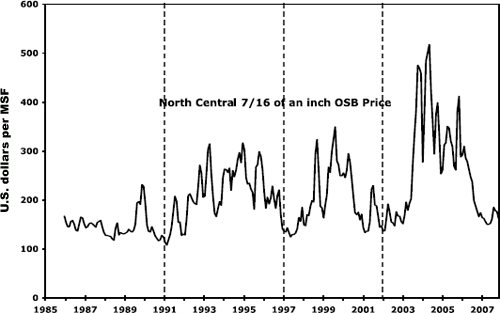| Home | About Us | Resources | Archive | Free Reports | Market Window |
This Obscure Commodity Could Quadruple Over The Next 10 YearsBy
Thursday, November 29, 2007
OSB is a construction material. It comes in large wooden sheets that look like plywood from a distance. They make it by gluing wood strands together with resin and squashing them into sheets. You've probably seen OSB in your local home-improvement warehouse. Or take a look the next time you pass a construction dumpster. Builders use OSB in the roofs, walls, staircases, and floors of most American homes. You may see strong demand for OSB before hurricanes. It's perfect for covering up windows. In Detroit, the city uses OSB to board up the doors and windows of thousands of abandoned houses to keep out squatters. OSB – short for "oriented strand board" – is one of the most important innovations in the home construction industry of the last 20 years. It's a direct substitute for plywood, yet it costs 50% less to produce. According to forest-product industry publisher RISI, 1,000 square feet of western Canada OSB costs $150. The same quantity of western Canada plywood costs $298. Substituting OSB for plywood saves a builder $700 on a 2,500-square-foot house. OSB performs better than plywood too... Producers make plywood by rotating a log over a blade and peeling off thin layers... like sharpening a pencil. They press these layers together with glue to form sheets. In this way, a piece of plywood can only be as long as the log it comes from. They can make OSB any size. Plus, with OSB, manufacturers can arrange the strands in certain directions to maximize its strength according to the contractor's specifications. In sum, OSB is a more consistent material than plywood, and it's stronger, more pliable, and easier to cut. Take a look at the chart below of OSB prices going back to the 1970s. See how cyclical its price is.
Right now, OSB prices are touching their lowest levels since 1991. The housing decline has decimated the market. Adjusted for inflation, OSB prices are easily the lowest they've ever been. As a crisis investor, it's a fantastic opportunity... I want to own OSB. Over the next 10 years, I can see OSB prices doubling, tripling, or even quadrupling from its price today. This is one of the most compelling trades I've seen in a long time. Here's why: OSB prices are so low, the market forces OSB manufacturers to sell it for less than it cost them to manufacture it. In other words, OSB producers are losing millions of dollars every day. This is not sustainable. Commodity prices cannot stay below their cost of production for long. If they did, the whole industry would collapse and the product would disappear off the face of the Earth. That's fine if no one wants the product. But with a useful commodity like copper or iron ore or OSB, sooner or later price has to rise above its production cost. Secondly, OSB isn't some kind of fad consumer product or an Internet start-up. It's an essential component in the construction of new houses. American homes are getting bigger, so they're using more OSB per house. Baby boomers are buying second homes, and legal immigration is increasing the U.S. population by around 1 million people a year. In short, demand for OSB will come back. OSB producers will be profitable again. We just need to wait for the storm to subside. Finally, even if the market for panel boards doesn't expand, I think OSB demand can still grow. It's like a Detroit auto-parts manufacturer once told me: "The depression in Detroit was the best thing to happen to my business. I made fasteners cheaper than anyone else in Detroit. When the bust came, everyone came to me to buy their fasteners." OSB is a much cheaper product than plywood. OSB will eat plywood's share of the market now that times are hard. How do you invest in OSB? You could buy a railcar of OSB and stash it in a warehouse for 10 years. But that's clumsy. Much easier to buy the stock in a company that produces OSB. I like Louisiana-Pacific (LPX) and Weyerhaeuser (WY). There's a third producer I like even more. It's smaller than LP and Weyerhaeuser, but it produces OSB cheaper than anyone else in the industry. I have this stock in my 12% Letter portfolio. Plus, it pays a 5% dividend, so we get paid while we wait. Good investing, Tom
Further Reading:
How To Profit From The Canadian Lumber Crisis Market NotesTHE STRONGEST – AND LEAST EXCITING – STOCKS IN THE MARKET A look at the current new highs list is a look at the boring and the beautiful... Sitting at the top: Colgate Palmolive... Procter & Gamble... Johnson & Johnson... coal stocks... and, soaring 88% this year, tractor and plow producer John Deere. We'll single out Deere for today's chart... as it's soaring share price tells us two things about the world: We'll note the new all-time highs reached by Colgate Palmolive and Procter & Gamble as further evidence of the "basics rally." Like Deere, these two makers of consumer basics are soaring as the Starbucks and Nordstroms of the world struggle. |
Recent Articles
|


